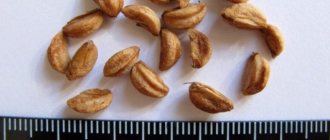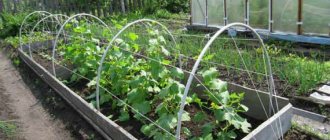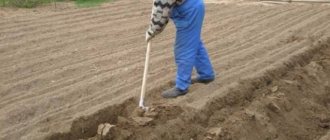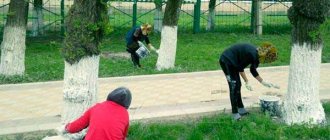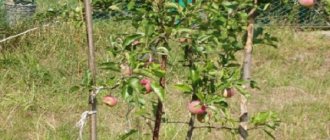7373
Rarely does a garden plot do without raspberries, but the presence of powerful bushes is not always the key to a rich harvest. If you are not happy with the size and quantity of berries, you have to plant a new raspberry tree. In this case, they decide when to transplant the raspberries to another place and how so that they quickly take root.
Seedling in its second year of growth
Why do raspberries need transplanting and seeding?
It is recommended to replant raspberries to a new location every 5 years. However, if fruiting also pleases you, then you can do it even less often. The main goal of regular replanting is to obtain a good and tasty harvest. Let's take a closer look at why you need to replant already formed plants:
- The bush, due to its natural nutrition, gradually depletes the soil. If there is a lack of nutrients, you can’t even dream of any good harvest.
- Over time, the raspberry forest thickens, and in such conditions the likelihood of the spread of diseases and the proliferation of pests increases. Transplantation helps solve the problem of thickening.
- Replanting helps renew the bush.
- Using this gardening procedure, you can transform your raspberry garden, making it more tidy.
Note ! The next year, after the autumn transplant, raspberries will not be able to please the gardener with a harvest, because they will need to build up the root system.
Pruning raspberries in spring
Pruning raspberries in the spring is an important and necessary part of raspberry tree care and the key to its good and regular fruiting. Raspberry shoots, as a rule, live only two years: in the first year they actively grow and branch, and in the second they bear fruit and die. In addition, unkempt bushes are susceptible to many diseases and pests, the berries become smaller in a short time, and the yield decreases sharply. Most gardeners consider spring to be the optimal time for pruning.
Latest articles about gardening
How to feed raspberries in summer
How to feed raspberries in spring
Pruning bushes in spring
When to transplant raspberries to another place: optimal timing in the fall
When performing the procedure, an important role is played not only by how correctly you transplant the shrub, but also when. Choosing the right timing for the procedure greatly influences the success of the event. The optimal time to transplant raspberries in the fall is 1 month before the first autumn frosts. This period occurs at different times in different regions, for example:
- in the middle zone (Moscow region) - late September, early October;
- in the South (Krasnodar Territory) - suitable dates fall in the second half of October;
- in Siberia, the Urals, the North-West (Leningrad region) - it is better to replant at the end of August or at the beginning of September.
When is it better to replant raspberries - in autumn or spring?
Raspberries can be replanted in both spring and autumn. If you follow the replanting scheme, the fruit bush will survive the “move” without problems and quickly adapt to the new place, regardless of when you do it.
However, it is believed that raspberries tolerate transplantation better and easier and adapt to another location if the procedure is carried out in the autumn.
It should be noted that in the fall it is optimal to plant and replant shrubs in the central zone and in the southern regions of the country. But in colder regions (Siberia, the Urals, Leningrad region), it is better to postpone the procedure to spring. Such recommendations are due to the fact that the shrub may not have time to take root in another place, and when a severe winter sets in, it may freeze and die.
Conclusion
There are no specific deadlines for replanting raspberries. In principle, this can be done in any season, when it is more convenient for the owner of the dacha (adjacent) plot. But if you have a choice, then autumn is better suited for these purposes. The exception is the renovated varieties, which produce their first harvest by mid-July. If they are replanted, then only in the spring, otherwise all their advantage over “regular” raspberries is lost.
The approximate period is from the last ten days of August to the end of September (for the middle zone). But the planting time can be adjusted, shifted to the beginning of October, if the local climate allows it.
To indicate a more precise date means to mislead the reader. Changes in weather conditions are no longer noted only by specialized specialists. They have become so noticeable that recommendations for replanting the same raspberries and other garden crops, which can be found in old (last years) calendars for gardeners, clearly do not correspond to reality.
So what should you focus on in relation to your site? Before the first cold weather, before plunging into a state of “hibernation,” the plant must have time to acquire a good root system and accumulate the supply of nutrients necessary for a successful winter.
Hence:
- it is necessary to study all the developmental features (stages, timing) of a particular raspberry variety;
- check the weather forecast for the next month and for the longer term. Local experts may not be able to indicate exact temperature values, but they are able to answer the question of whether spring (autumn) will be long or short-lived.
Based on these data, you can competently plan the work of replanting raspberries, taking into account its variety and all local specifics. If we focus on average parameters, then the time interval from the moment the shoots are planted in the ground until the first frost should be approximately 4 - 5 weeks. This is enough for the raspberries to take root and safely withstand low temperatures.
Where to transplant raspberries in the garden: choosing a new location
The berry crop has a number of requirements for the growing location. And therefore, if you want to receive a generous harvest every year, the new plot must meet these criteria.
First of all, the place for raspberries should be well illuminated by the sun (slight shading during the hottest hours is desirable). The location should be protected from strong and cold winds. You cannot replant berry bushes in lowlands, marshy, shady areas.
The soil in the new site should be fertile, air- and moisture-permeable, neutral in acidity, and well-drained. It is best to replant or plant the bush on loamy or sandy loam soil that meets all requirements.
When choosing a new location, it is recommended to follow the rules of crop rotation. Good predecessors for raspberries: legumes (beans, peas), green manure, cucumbers, zucchini, onions, garlic. Bad predecessors for berry bushes are raspberries themselves, as well as potatoes and strawberries.
Transplant in summer
You can plant raspberries in the summer. However, at this time it is worth taking much more seriously both the choice of place and time for this procedure. Since it is hot at this time of year, replanting should be done in the evening or in the morning, when the sun is not yet very scorching. When choosing a location, you should definitely take into account that the plant does not like direct sunlight, so you should choose shady areas of the estate with diffused light. Also make sure that the soil for planting is not very loose. They especially love bushes if there are boulders nearby. It is imperative that when replanting a plant in the summer, the soil must first be fertilized, preferably with a herbal infusion. At the end of summer, when the harvest has already been harvested, the old raspberry shoots must be removed and a few new shoots left for the winter. Do not forget to water the bushes in the hot season, when there is drought.
Blackcurrant diseases: methods of control and prevention
Scheme for preparing the site and planting holes
Preparing a new place for planting raspberries is an important step. The more suitable the soil, the faster the shrub will take root and the better it will bear fruit in the future.
How to prepare the soil
It is recommended to prepare the site approximately three months before the autumn transplant, or at least 3-4 weeks before the event. Before digging, you should add compost or humus to the soil (about 6-8 kilograms per 1 square meter). In addition to organic fertilizer, it is useful to add mineral fertilizers, for example, superphosphate (phosphorus) and potassium sulfate (potassium) according to the instructions for the preparation. If you want to use only organic matter, then instead of mineral phosphorus-potassium fertilizers, you can add wood ash (300 g per square meter).
If the soil in the garden plot is acidic, then it is necessary to deoxidize the soil. For example, you can add dolomite flour and wood ash.
Fertilizers can be applied along with the transplant directly into the hole or trench. To do this, you need to pour a small handful of fertilizers into each hole (or under each plant in the trench), mix them, and then sprinkle a layer of earth on top (about 5-7 cm).
By the way, under natural conditions this crop grows well on rotting wood debris. Therefore, it is useful to place a small amount of sawdust, wood shavings, and branches in the planting hole (or trench). And be sure to put a layer of ordinary soil on top.
How to prepare and dig holes (trenches)
Raspberries can be planted and replanted in two ways: bush (in separate onions) and trench or belt (in a common trench).
To transplant using the bush method, you need to dig planting holes at a distance of 50-70 cm from each other, the diameter and depth of the hole is 40 cm. The distance between the rows is 1.5-2 meters.
With the trench method, it is necessary to dig a trench: 40 cm deep and wide. The optimal length of one trench is about 1.5-2 m (3-4 seedlings can be planted in it at a distance of 0.5-0.7 m from each other). The distance between trenches is 2 m.
By the way! When digging a planting hole or trench, the top fertile layer of soil should be thrown into a separate pile. The soil will be useful when burying the seedling.
How to tie raspberries in spring
For better illumination of the raspberries by the sun, they should be tied with twine. To do this, stakes or pipes are driven in at the beginning and end of the row. 3 rows of twine are tied to them, better than aluminum wire - it does not rot. The bottom row is 50 centimeters from the ground, the middle one is 1 meter and the third, top row is 1.5 meters from the ground. This not only improves the sun exposure of raspberries, but also increases their productivity and makes it convenient for garden owners to pick berries.
How to prepare a raspberry bush for autumn replanting
After transplantation, any plant directs all its strength to rooting in a new place. If it spends resources on building up green mass, this will be to the detriment of restoring the root system, which means that the shrub will take longer and worse to take root and take root in a new place. And if the bush does not have time to take root, then in winter it can freeze and die. For this reason, immediately before transplanting, you need to trim the raspberries. The raspberry bush is pruned to 40-60 centimeters in height.
In addition to pruning, when replanting in autumn, it is necessary to tear off all the leaves of young seedlings (root shoots, suckers).
How to feed raspberries in the fall
Autumn cultivation should begin with the base, and this is the soil. We remove the covering from the earthen soil - mulch and the remains of leaves, rake it up and send it to the fire or to the compost pit. You cannot leave it for the winter, otherwise harmful organisms will appear and field mice may take up residence.
Then you should dig up the soil, under no circumstances burying yourself deeply into the ground, because the root system of our shrub is superficial. Recommended depth:
- in rows - by 8-10 centimeters;
- in row spacing - no more than 20 cm.
Instructions for transplanting an adult (old) raspberry bush to a new location
For replanting, it is necessary to choose exclusively healthy, strong bushes. You can correctly transplant an adult raspberry to another place using the following step-by-step instructions:
- Decide on a location, prepare the site, dig planting holes or a trench.
- Now you need to dig up the bush. To do this, dig around it in a circle. The shovel should be positioned exclusively vertically to avoid damaging the roots.
- The next step: moving the bush along with the earthen ball. The procedure must be completed as quickly as possible.
Important! Raspberry transplantation must be done very quickly. The sooner you plant a shrub in a new place in the open ground, the faster and better it takes root and adapts. The shrub should not be allowed to remain in the air for a long time.
Advice! If the dug up bush needs to be moved (or transported) to another remote place, then it is necessary to wrap the earthen lump with damp spunbond (or wet newspapers), and then place the lump in a bag.
- If you are interested in transplanting and propagating raspberries by dividing the bush , then you need to follow some steps. After the bush is moved to a new location, you will need to divide it. The division can be done with your own hands or with a garden knife. It can be divided into several parts. Each part should have 2-3 healthy, strong young shoots and developed roots.
- Then you should place the plant in the planting hole: For normal transplanting without dividing the bush, simply place the earthen ball in the hole. The root collar should be flush with the ground surface.
- If you have divided the raspberry bush, then the earthen lump has already been damaged, so you need to dip the bare roots in a clay mash before planting. Carefully place the plants in the planting hole, spreading out the roots so they lie flat. The root collar should also be level with the ground surface.
After replanting, it is recommended to water the shrub with a preparation that stimulates the formation and growth of roots, for example, Kornevin, for better rooting.
Thus, we can confidently say that periodic replanting, carried out according to the correct scheme, will definitely not cause trouble for the summer resident and will contribute to a regular, luxurious harvest. Next season, after a successful transplant, you need to pay due attention to caring for raspberries. Timely watering, fertilizing, treatment against diseases and pests, and garter will help to achieve a healthy and strong raspberry tree, giving a tasty and large berry harvest.
Caring for transplanted raspberries
The purpose of further care is to help the seedlings take root, take root and not die in winter. When planting in autumn, seedlings are not pruned, but only pinched so that the nutrients in the leaves and stems work to strengthen and develop the roots.
Did you know? Presumably, the name “raspberry” comes from the word “small”, since its berries consist of many small fruits. However, it is possible that it is based on the Latin word “mulleuz” - reddish.
Immediately after spring planting, prune the seedlings to 20–30 cm from the ground. When new shoots appear at the base of the plants and reach a height of about 20 cm, cut out the remains of the old stems at ground level. Shortening the stem length by more than 15 cm reduces yield, and to avoid this, the ends of long stems should be tilted and tied to a trellis.
It is necessary to mulch new plantings with a 10 cm layer of straw - this significantly increases the rooting ability and survival rate of plants. However, straw mulch should only be used during the establishment period because excessive moisture under the mulch can increase the risk of root rot.
Mulch and herbicides can be used to control weeds after planting. To suppress weeds, it is recommended to plant slow-growing turf grass between rows.
Fairy tale pear: description, growing secrets, proper care
Newly transplanted raspberry plants should be watered regularly and provided with shade. Do not allow plants to dry out during periods of drought and ensure that the soil is constantly moist at a depth of 25–35 cm. A good practice may be to collect rainwater for irrigation and use a drip irrigation system in summer to avoid the top layer of soil eroding and water getting on leaves and flowers , berries.
To combat harmful infestations, try to use all available methods to reduce the likelihood of disease and insect damage. Many pest problems can be avoided by choosing the right site, as well as through crop rotation, selection of varieties, tillage and planting healthy plants without signs of disease. All shoots that appear outside the planting area should be weeded out, maintaining a row width of about 30 cm.
Features of autumn care
Although raspberry bushes can tolerate low temperatures, frosts in both fall and spring can damage dormant plants.
Find out what and how to process raspberries in the fall.
There are several options for protecting raspberries from frost and the destructive effects of winds:
- transplanting raspberries under the protection of fences or walls of personal buildings;
- mulching the plantation for the winter with a thick layer (20–25) cm of mulch;
- covering with agrofibre, spruce branches or any other insulation;
- providing a sufficient layer of snow so that the leaf part of the seedlings remains in the optimal comfort zone. Wooden panels, tall stalks of corn and sunflowers, and spruce branches are used as snow-retaining structures.
If the snow crust becomes icy, it should be broken through so that the raspberries have access to air.
Spring transplantation and fruiting
Planting near the northern wall of garden buildings will allow raspberries to remain dormant longer in the spring and protect them from freezing in the event of spring frosts. Waking up bushes when the temperature is forecast to drop should be protected with additional covering material at night.






